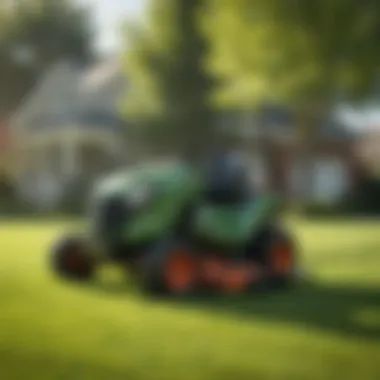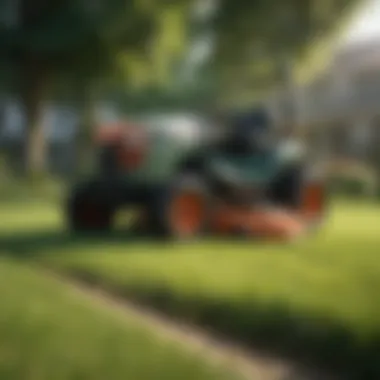American Pride: A Journey Through Lawn Mower Evolution


Topic Overview
Lawn mowers have become an indispensable element of American life, embodying a blend of practicality and cultural significance. The simple act of cutting grass speaks volumes about the values held in communities across the nation. It is about pride in one’s home, maintaining aesthetics, and, perhaps most importantly, fostering a connection to the outdoors. This overview serves to unpack the layers of importance behind lawn mowers, weaving through history and modern advancements that have helped shape their role today.
Definition and Importance
A lawn mower is, at its core, a machine designed to trim grass, but it represents much more. It's a tool that underscores the American ethos of property ownership and individualism. An impeccably manicured lawn can reflect the owner's dedication to upkeep and beauty, serving as a canvas for personal expression. The ritualistic mowing of grass speaks to a simplicity that resonates deeply within many people, offering both a sense of peace and accomplishment. In broader strokes, the evolution of lawn mowers mirrors advancements in technology, shifts in environmental consciousness, and changes in consumer preferences.
A lawn's appearance often influences neighborhood pride and community standards. A vibrant, well-maintained yard can elevate property values, create inviting spaces for family and friends, and foster community pride.
Brief History and Evolution
Lawn mowers have a rich history. The first mechanical lawn mower was invented in 1830 by Edwin Beard Budding, intended for use on sports lawns and gardens. Over the decades, the humble mower evolved significantly. Early models were horse-drawn, highlighting the connection to agricultural practices of the time.
As suburbia expanded in the 20th century, so did the demand for lawn care. The post-World War II era saw a surge in lawn ownership and interest in personal gardening, which aligned perfectly with innovations in mowing technology. From the introduction of the rotary mower to the development of electric models, each advancement aimed to make lawn care more efficient and accessible. In many ways, the lawn mower evolved alongside American culture—mirroring societal values focused on home improvement and community aesthetics.
Over the years, consumer preferences have shifted due to technological advancements and environmental concerns. Presently, options such as robotic mowers and electric models have emerged, emphasizing sustainability alongside convenience. The playful dance of grass beneath a rotating blade carries a significant weight, not just in labor but in the legacy it leaves behind.
"A well-kept lawn is a reflection of the dignity of its caretaker."
With this overview in mind, we can delve deeper into the innovations shaping the lawn care landscape and the significant impact these machines have on both the beauty of our environments and our approach to sustainable practices.
The Historical Development of Lawn Mowers in America
The journey of lawn mowers in America is not just a tale of mechanical ingenuity; it mirrors the evolving values and aspirations of a nation. Understanding this historical narrative is crucial as it provides insights into how lawn care transitioned from a labor-intensive chore to an expression of personal pride and creativity. Lawn mowers represent technological progress and the American spirit of innovation, reflecting a growing desire for beauty in suburban landscapes and a shift in how society perceives outdoor spaces.
Early Innovations and Designs
In America, the story of lawn mowers begins in the 19th century. The first patent for a reel mower was granted to Edwin Beard Budding in 1830. Although it was initially designed for use on sports fields and golf courses, it gradually found its way into residential lawns. This mechanical contraption, made from iron and wood, paved the way for a fresh approach to grass cutting.
The early designs had a lot of room for improvement. They were often heavy and required significant physical effort to operate. Some households would congregate in the local hardware shop, admiring these new gadgets and eagerly discussing their merits. The reel mower represented a step away from scythes and hand clippers. Its design was simple yet ingenious, allowing users to cut grass more efficiently than ever before.
- Steel blades replaced wooden ones.
- The handle evolved into a more ergonomic design.
- Innovations in wheel design facilitated easier navigation.
Despite their limitations, these inventions ignited a passion for lawn care in many Americans, with countless homeowners now engaging in regular mowing for aesthetic appeal rather than mere necessity.
The Rise of Gas-Powered Models
Fast forward to the 20th century, and the introduction of gas-powered mowers marked a significant transformation in lawn care practices across America. The 1940s saw a surge in the use of small engines in lawn mowers, which drastically shifted the way people approached lawn maintenance. Homeowners could now tackle larger grassy areas without breaking a sweat, making tending to lawns less of a chore and more of a weekend hobby.
Gas-powered mowers quickly became a staple in American households. One could often hear the distinctive roar of engines echoing through neighborhoods on sunny Saturday mornings, as residents took pride in maintaining their meticulously trimmed lawns.
The allure of gas-powered mowers included:
- A vast increase in cutting power and speed.
- Enhanced mobility with self-propelled models.
- An array of cutting heights and options, allowing for customization.
However, the benefits were not without their drawbacks. Many homeowners were unaware of the significant environmental implications that came with gas-powered mowers, such as increased air pollution and higher carbon emissions. This conflict began to lay the groundwork for a future shift in consumer preferences.
Transition to Electric Mowers
As awareness about climate change and environmental impact grew, so did interest in electric mowers. By the late 20th and early 21st centuries, electric lawn mowers began to emerge as a quiet, eco-friendly alternative to their gas-powered predecessors. These mowers promise less noise pollution and lower emissions, appealing to homeowners looking to reduce their carbon footprints.
Furthermore, technological advancements have led to innovations in battery technology. Today’s electric mowers often come equipped with powerful lithium-ion batteries, enabling them to run longer on a single charge. Features that before were only dreams are now reality:


- Cordless operation allows for unrestricted movement.
- Smart mowers equipped with software to enhance cutting efficiency.
- Lightweight designs make handling a breeze.
People often find themselves more connected to their green spaces when using these environmentally friendly tools, promoting a shift towards sustainable lawn care practices. It’s becoming clear that the evolution of lawn mowers reflects broader societal changes—prioritizing not just aesthetics and convenience, but also responsibility and love for the environment.
Cultural Significance of Lawn Care
Lawn care in America transcends the simple act of cutting grass; it’s a tapestry woven into the fabric of American society. This significance isn’t merely about aesthetics but also reveals broader cultural values such as hard work, community pride, and environmental awareness.
The American Dream and Lawn Aesthetics
The notion of the American Dream often conjures up images of a picturesque home with a lush green lawn. It symbolizes success and stability — a marker of prosperity that many aspire to achieve. The manicured yard serves as an outdoor living room where families gather, kids play, and neighbors connect. The aesthetic value of a well-kept lawn is clear; it acts as a canvas for personal expression, showcasing various landscaping styles and designs.
In keeping with this trend, many homeowners are increasingly investing in not just the lawn itself, but also in ornamental features like flower beds, fountains, or decorative stones which all contribute to that quintessential suburban bliss. To reinforce the pursuit of beauty, numerous lawn care products have emerged, from eco-friendly mowing options to advanced irrigation systems aimed at maintaining a vibrant lawn throughout the seasons.
Symbolism of Green Spaces
Green spaces are more than just patches of grass; they represent life, rejuvenation, and nature's efforts in urban settings. Lawns allow for a symbiotic relationship with the environment — they filter air, decrease soil erosion, and provide habitats for various species. Furthermore, the presence of vibrant green lawns in neighborhoods evokes a sense of peace and community health. The sight of lush green can lift spirits and promote relaxation amidst busy lives.
Additionally, from a cultural standpoint, having a well-kept lawn is often viewed as a social responsibility. Maintaining these green spaces reflects not only on the homeowner but to some extent, on the community. They signify respect for neighbors and a commitment to communal aesthetics. This perspective can be traced back to the earliest settlers, who tended their lands as a source of pride and sustenance.
Community Engagement Through Lawn Care
The act of caring for one’s lawn often fosters community ties. When residents engage in lawn maintenance, they invariably interact with their neighbors, whether it's sharing tips, lending tools, or taking part in community beautification projects. Such interactions stem from a basic human tendency to connect with others through shared experiences and common goals.
Community events focused on lawn care, such as neighborhood 'mow days' or landscaping contests, bring people together. These gatherings not only cultivate friendships but also instill a sense of ownership and collective responsibility towards the community's appearance. Through these actions, lawn care becomes a conduit for collaboration and social engagement.
"The lawn is not just a patch of grass; it’s an extension of our identity as neighbors, as families, and as citizens."
In summary, the cultural significance of lawn care in America extends beyond mere aesthetics or personal satisfaction. It embodies the values of the American Dream, symbolizes the importance of green spaces, and engages communities. As the landscape continues to evolve, so too will the role that lawns play in American culture, reflecting not only individual desires but also collective aspirations.
Technological Advancements in Lawn Care
The realm of lawn care has undergone a remarkable transformation, fueled by technological advancements that not only enhance the efficiency of maintaining outdoor spaces but also reshape our relationship with nature. As landscaping moves away from traditional methods, the importance of embracing technology becomes apparent—not just for creating pristine lawns, but also for sustainable practices and smart integration into everyday life. Each innovation enables homeowners and lawn care professionals alike to cultivate healthy green spaces with minimum hassle.
Smart Mowers and Automation
The shift towards smart mowers has revolutionized lawn care, letting machines do the heavy lifting while allowing homeowners to focus on more pressing matters. These devices, often characterized by robotic design, can navigate lawns autonomously. Equipped with sensors, they detect boundaries, avoid obstacles, and even adapt their cutting patterns based on the growth rate of grass. The benefits are manifold:
- Time-saving: With smart mowers, precious hours of labor are freed up for other activities.
- Consistency: Automated mowing ensures that lawns maintain a uniform look, which can enhance curb appeal.
- Resource efficiency: Many models optimize power consumption, thus reducing electricity needs during operation.
Innovations such as smartphone connectivity also offer users the ability to schedule mowing sessions and monitor their mowers remotely. This leap into automation represents a promising move toward a more streamlined lifestyle, blending technology seamlessly with our outdoor environments.
Sustainable Lawn Maintenance Innovations
As environmental concerns rise, so does the demand for sustainable lawn maintenance solutions. Advances in this area reflect a growing awareness about the long-term effects of conventional lawn care practices. Innovations aimed at sustainability are not just beneficial for the planet—they also enhance soil health, reduce input costs, and promote biodiversity. Key components of this shift include:
- Electric mowers and equipment: With minimal emissions compared to gas-powered alternatives, electric options present a cleaner way to maintain landscapes.
- Smart irrigation systems: These advancements utilize weather data to determine the optimal times and amounts for watering, minimizing waste while promoting healthy grass growth.
- Organic fertilizers and pesticides: Emphasizing a return to nature, these products help restore soil balance and mitigate potential harm to local ecosystems.
Engaging in sustainable practices is increasingly seen as a badge of honor among homeowners and lawn care experts, reinforcing the sense of responsibility towards the environment.
Integration of GPS Technology
Integrating GPS technology in lawn care isn’t just about luxury; it’s about efficiency and accuracy. With GPS, users can define specific zones in their yards that require tailored care or maintenance. This precision helps to:


- Reduce overlap: Ensuring that every section of lawn receives the right amount of care without redundancies saves resources and time.
- Track performance: GPS technology can gather data on mowing patterns or grass health, influencing future care decisions based on measurable outcomes.
- Facilitate landscape design: Mapping out a lawn using GPS allows homeowners to visualize changes without physical alterations—cutting down potential costs in landscape redesign.
Environmental Impact of Lawn Maintenance
Lawn maintenance is not just about aesthetics or adhering to neighborhood conventions; it delves into a realm that has significant environmental implications. As we navigate the landscape of American culture, the impact of lawn care practices becomes ever clearer. Increasing awareness of environmental issues means that homeowners and professionals alike must consider the effects of their methods on nature. Topics such as the carbon footprint of lawn equipment, water usage efficiency, and the implications of pesticide and fertilizer application are now at the forefront of this discourse.
A robust understanding of these factors is vital for fostering a sustainable environment while preserving the beautiful green spaces we cherish. Not only does lawn care touch on ecological health, but it intertwines with community wellbeing, creating a ripple effect throughout society.
Carbon Footprint of Lawn Equipment
The carbon emissions generated by lawn maintenance tools represent a sizeable piece of the puzzle. Gasoline-powered lawn mowers, in particular, have garnered substantial scrutiny. The emissions from an average gas mower can resemble that of a modern car, spewing greenhouse gases while operating for just an hour.
To put it into perspective, a gas mower emits about 150 grams of carbon dioxide per hour. This output contributes significantly to air pollution, which has a cascading effect on climate change and health issues among densely populated areas that are heavily landscaped.
While electric mowers offer an eco-friendlier alternative, not all are created equal. The source of electricity—whether from fossil fuels or renewable resources—alters the environmental footprint drastically. The need for battery disposal, too, raises concerns about waste management in the long run. Thus, it's essential for consumers to weigh the options and support brands that prioritize sustainability in their manufacturing processes, leading to a potential reduction in emissions.
Water Usage and Conservation Techniques
Water scarcity has increasingly become a pressing issue across America, and lawn maintenance practices contribute significantly to this concern. Traditional practices may demand copious amounts of water to keep lawns lush and green, particularly in arid regions.
To address this, innovative conservation techniques have emerged, offering a compromise between maintaining aesthetic lawns and conserving precious water resources. Here are a few notable methods:
- Drought-resistant landscaping: This technique involves selecting plants that require less water, promoting native flora—these plants are inherently adapted to local conditions, thus thriving with minimal irrigation.
- Rainwater harvesting: Homeowners can utilize rain barrels or cisterns to collect rainwater for lawn watering, dramatically reducing reliance on municipal water supplies.
- Soil monitoring and smart irrigation systems: Technology has facilitated the use of sensors that determine soil moisture levels. These systems enable homeowners to water only when needed, ensuring that neither water nor money is wasted.
By implementing these strategies, lawn care can become more eco-conscious while still achieving that desirable lush look.
Pesticides and Fertilizers: Risks and Alternatives
The use of chemical fertilizers and pesticides raises valid concerns due to their environmental and health implications. For starters, runoff from lawns treated with these substances can pollute local waterways, disrupting aquatic ecosystems and harming wildlife. The long-term effects of these chemicals on soil health and biodiversity also pose significant challenges.
Consequently, many homeowners are now exploring safer alternatives. Organic fertilizers, derived from natural materials like compost or manure, are gaining traction. These products enrich the soil without having harsh impacts on the environment.
Furthermore, integrating Integrated Pest Management (IPM) strategies can reduce reliance on pesticides:
- Cultural controls: This includes practices like crop rotation and selecting plant varieties that are resistant to pests, minimizing the need for chemical interventions.
- Biological controls: Utilizing natural predators to manage pest populations can drastically decrease reliance on harmful chemicals.
"The root of the problem lies in our choices; shifting our gaze towards more sustainable lawn care can cultivate not just greener lawns, but also a healthier planet."
In summary, understanding the environmental impact of lawn maintenance fosters a more conscientious approach to caring for our green spaces. As innovations arise, the choice between tradition and sustainability becomes crucial to the legacy we wish to leave for future generations.
Consumer Preferences and Trends
The topic of consumer preferences and trends serves as an essential aspect of the lawn care industry. Understanding what drives consumers to choose specific products and practices is vital for manufacturers and retailers alike. Several factors influence these choices, from environmental concerns to marketing strategies. By examining these trends, stakeholders can better align their offerings with consumer expectations, fostering a more sustainable and competitive market.
The Shift Towards Eco-Friendly Options
In recent years, there has been a noticeable shift towards eco-friendly lawn care options. As environmental awareness grows, consumers are opting for products that minimize their ecological footprint. Electric mowers have gained traction, not only for their lower emissions but also for their quiet operation. Many homeowners are also exploring organic fertilizers and pest control methods, which are perceived to be safer for ecosystems and families alike.
- Consumer Awareness: People are increasingly educated about the environmental impact of traditional lawn care methods. Facts show that gas-powered mowers can produce up to 3% of the country’s air pollution.
- Sustainability: Consumers now favor brands that demonstrate a commitment to sustainable practices. Whether it's through recyclable packaging or sustainable sourcing of materials, eco-friendly options have become a badge of honor.
- Cost Savings: Electric mowers often present a lower cost of maintenance in the long run, appealing to budget-conscious buyers. This shift not only reflects a change in consumer priorities but also represents an opportunity for brands to innovate.
Brand Loyalty and Marketing in the Lawn Care Industry
Brand loyalty plays a significant role in shaping consumer behavior in the lawn care sector. Consumers tend to remain loyal to brands that offer quality and demonstrate a strong connection with their needs. Marketing plays an equally important role, as it shapes perceptions about products and influences buying habits.


- Quality Assurance: Brands like Honda and Toro have built reputations for reliability, which fosters trust. Consumers leaning on familiarity often repurchase, believing that a known brand will deliver consistent performance.
- Relationship Building: Companies increasingly focus on building relationships with their customers. Engaging content, personalized experiences, and responsive customer service are key to keeping consumers connected to a brand.
- Targeted Advertising: With the rise of digital marketing, companies can tailor ads to specific consumer demographics. This precision helps them reach an audience most likely to respond positively, effectively enhancing brand loyalty.
The Influence of Online Reviews and Social Media
The digital landscape today is heavily influenced by online reviews and social media interactions. These platforms serve as modern-day word-of-mouth, where consumers share their opinions and experiences.
"In a world driven by information, the voice of the consumer has never been so powerful."
- Consumer Trust: Potential buyers often turn to reviews before making a purchase. Platforms like Reddit and Facebook provide quick access to user opinions, enabling consumers to make informed choices.
- Transparency: Brands that engage with customers provide transparency and foster a sense of community. Responding to inquiries or addressing negative feedback publicly can strengthen a brand's reputation.
- Impact of Influencers: The role of social media influencers has grown, particularly among younger consumers. When an influencer recommends a product, sales can skyrocket overnight, emphasizing the importance of maintaining a positive online presence.
In summary, understanding consumer preferences and trends in the lawn care industry reveals a landscape shaped by environmental responsibility, loyalty to trusted brands, and the influence of digital interactions. These elements not only guide current market dynamics but also set the stage for future advancements in lawn care products and practices.
The Future of Lawn Mowers
The landscape of lawn care is continually evolving, driven by a myriad of factors ranging from technological advancements to shifting consumer behaviors. In the forthcoming sections, we will explore what lies ahead for lawn mowers in America. This discussion is crucial for a number of reasons. Understanding the potential future developments in lawn care equipment not only illustrates the ongoing relationship between innovation and consumer demand but also highlights how these trends will shape our green spaces and community engagement. This foresight will equip lawn care enthusiasts and agriculture professionals alike with valuable knowledge to navigate the forthcoming changes in this vital industry.
Predictions for Technological Innovations
As we peer into the future of lawn mowers, the anticipation of new technological breakthroughs is palpable. One of the most significant trends to watch is the rise of smart mowers that leverage artificial intelligence and IoT technology. These devices promise more precise mowing patterns, autonomous operation, and even integration with smart home systems. Imagine a mower that not only knows your lawn's specific layout but can also interpret weather conditions, adjusting its schedule accordingly to ensure optimal grass health.
In addition, the development of battery technology cannot be overlooked. As we pivot towards more sustainable practices, advancements in battery life and efficiency will enable electric mowers to rival their gas-powered counterparts. This will not only reduce emissions but also lower maintenance costs. Furthermore, the integration of crop sensors can allow mowers to assess grass health, suggesting tailored maintenance solutions that respond to diverse lawn conditions.
Potential Changes in Consumer Behavior
Consumer preferences are expected to shift as the demand for environmentally friendly and technologically advanced options grows. The modern homeowner is becoming increasingly conscious of their ecological footprint, and this sentiment will steer many towards electric and hybrid models. The convenience that smart technology offers, including remote access and scheduling through mobile apps, is likely to appeal strongly to busy families and professionals.
Moreover, with the growing popularity of community gardening and local farm initiatives, more people might consider co-op lawn care services, sharing ownership or rental of advanced mowers. This community-centric approach can not only lower costs but also foster better relationships within neighborhoods, reflecting a broader trend of collaboration in society. Through all these changes, companies that stay attuned to these evolving consumer demands will likely lead the market.
Regulatory Impact on Lawn Care Equipment
As we navigate this changing landscape, regulatory frameworks concerning lawn care equipment must not be overlooked. Greater scrutiny is now being placed on emissions standards for gas-powered mowers due to rising environmental concerns. States may implement stricter regulations or incentives for adopting green technologies, further propelling the shift towards electric and more efficient alternatives.
In addition, there is a growing tendency for municipalities to set up guidelines for lawn care practices to foster sustainability in urban environments. This could lead to legislation that mandates mower usage during specific hours to minimize noise pollution and promotes eco-friendly maintenance practices. The challenge for manufacturers will be to stay ahead of these regulatory changes and adapt their products accordingly, ensuring compliance while also meeting consumer needs.
The future of lawn mowers is poised to blend technology with environmental stewardship, presenting exciting opportunities for consumers and manufacturers alike.
The continuous evolution of lawn mowers speaks to a larger narrative of how we care for our homes and environments. By paying attention to technological innovations, shifts in consumer behavior, and regulatory impacts, stakeholders in the lawn care industry can position themselves strategically for success in the years to come.
Concluding Thoughts on American Pride in Lawn Mowers
In reflecting on the prominence of lawn mowers in American society, it becomes evident that the journey of these machines goes beyond mere functionality. The interplay between tradition and innovation serves as a microcosm for broader societal evolution. Lawn mowers, as common as they are in American homes, symbolize a cultural commitment to maintaining green spaces, fostering community spirit, and navigating the challenges of contemporary environmental concerns.
The Balance Between Tradition and Innovation
The American lawn mower has undergone a fascinating evolution. On one hand, we have the traditional, push-powered mowers known for their simplicity and manual operation, harking back to a time when lawn care was a labor of love and physical effort. These devices not only allowed individuals to connect with nature but also served as a rite of passage for many young Americans learning responsibility. The rhythms of cutting grass reflect an age-old practice, guiding not only the growth of grass but shaping a deep-rooted connection to one's home.
On the other hand, innovation has made significant strides in the realm of lawn care. Modern gas-powered and electric mowers exemplify advancements, offering features that simplify mowing. Smart mowers, for instance, utilize technology to navigate lawns autonomously, saving time and reducing physical strain. Yet, amidst this shift toward convenience, one must consider how blended traditions with modernity can preserve community connections. For example, the resurgence of neighborhood mowing competitions pays homage to those simpler days while incorporating today's tech-savvy tools.
As we look to the future, striking a balance between these traditions and innovations becomes crucial. The lessons drawn from past practices can guide sustainable approaches that honor the essence of lawn care while embracing modern solutions, ensuring the legacy continues for generations.
Empowering Communities Through Green Spaces
Lawn mowers do more than tame unruly grass; they play a pivotal role in enhancing community aesthetics. A neatly mowed lawn creates an inviting atmosphere, fostering a sense of pride not only in individual homeowners but across neighborhoods. The ambiance set by a manicured lawn can uplift spirits and stimulate gatherings of family and friends.
Moreover, these green spaces serve as essential social hubs, where community events can unfold. Consider local gardening clubs or seasonal festivals that celebrate the beauty of well-kept lawns, encouraging collaboration and camaraderie among residents. In essence, investing in lawn care can lead to stronger community ties, as people gather to share tools, tips, and experiences.
The responsibility also extends beyond mere appearance. Lawns can contribute to local ecosystems, supporting biodiversity within urban settings. In this context, the conscious choices surrounding lawn mowing practices can have meaningful environmental implications. By choosing eco-friendly equipment and sustainable grass care practices, communities not only improve their local environment but also promote a culture of stewardship.
"Lawn care is not just about aesthetics; it's a bonding opportunity, a chance to come together and celebrate nature's beauty together."



